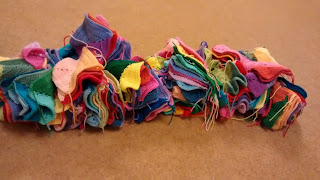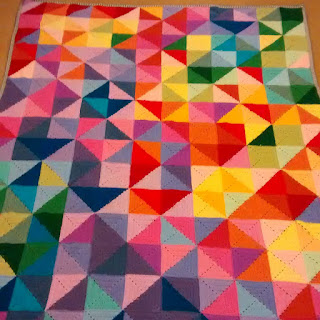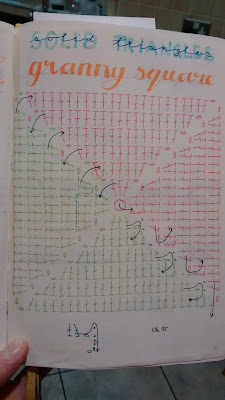YAAAAAAAY!!! When I saw the Postcards from Sweden quilt pattern from Jeliquilts here, it was love at first sight. However, I couldn't afford to quilt it, because this would tie me in to making 2 quilts plus a crochet blanket. You see, one boy has a crochet blanket so the other was clearly owed one. I didn't dare add quilting debts to this. So I had to make the Postcards from Sweden as a crochet blanket for the smallest boy.
Because I cannot step away from the day job, I matched the yarn colours to the original Kona fabrics by writing a python script. What else would you do?!
The very lovely Kelly has kindly agreed that I can share my colour list with you so you can recreate her work in yarn too! You'll need to head on over here to download her free pattern, but really you only need to print pages 6 and 7 which describe her layout. From there, you can write in the yarn colours in to her handy chart and then it's a crochet-by-numbers exercise, and a very lovely one it is too.
Here's the yarn colours I used, numbered to match the original quilt scheme:
- Tomato
- Matador
- Lulk *
- Pomegranate
- Sage
- Green
- Pistachio
- Leuven *
- Citron
- Apricot
- Saffron
- Spice
- Pistachio
- Kelly Green
- Aspen
- Cloud Blue
- Denim
- Turquoise
- Empire
- Lapis
- Sherbet
- Wisteria
- Magenta
- Amstelveen *
- Amstelveen *
- Lavender
- Lipstick
- Amersfoort *
- Lulk *
- Clematis
- Fondant
- Fondant
- Knokke *
- Spice
- Sunshine
- Spring Green
All colours are Stylecraft Special DK, except those marked with an asterisk which are Scheepjes Colour Crafter. That's 31 distinct colours, I used less than 100g of each colour.
The border is made up of three additional Stylecraft colours:
- Grey
- Graphite
- Cream
In terms of the blocks, they're a solid granny square of UK treble crochet worked in two colours at once, which is achieved by reversing the work direction. I bring you a diagram:
I worked 6 rounds for each block. The only non-standard bit is where you reverse direction - after 2 ch, slst into the start of the round, then turn the work and slst back over the ch and then get ready to ch 3 to act as your first tr and you're away again.
Don't worry if the diagram is opaque - I made some video tutorials, so hopefully the diagram will be a good reminder once you have watched them.
There are three parts to the videos:
For the border, I used 5 rounds of linen stitch from the Attic24 blog here. The colour order is Grey, Cream, Graphite, Cream, Grey. Again, I was just trying to mimic my favourite quilt binding I've seen on the postcards quilt!
I found it important to keep track of all the squares by storing them on stitch markers as I made them to keep them in order. Scrap yarn through a square corner would do just as well.
 |
| It's like a rainbow slug on my floor. |
There's no need to fork out for a posh blocking board as long as you've got access to an electric drill and some MDF. I've heard some people suggest 3mm DPNs as good blocking pegs, but you can save your pennies - 3mm stainless steel rod is widely used in remote control hobby aircraft, so grab yourself some cheap on eBay. I bought mine too long and owe thanks to my Dad who chopped them up with his grinder. Sorry Dad. Then just drill yourself some holes and pop the pegs in.
The blocks are whip-stitched together (I didn't want a visible seam - I wanted to match the quilt look as close as I could).
My little boy now has his own blanket which will doubtless get trashed in den building (as it should be, of course). If you have kids and are not sure if the blanket is needed - it always is. Did I mention they look as good as new after a machine wash and tumble dry?!
In my gauge the blocks are 5" square and the blanket comes out approximately double bed sided. For scale, a real human on the blanket:
Once again, huge thanks to Jeliquilts for offering her quilt pattern to us all for free. I can honestly say I enjoyed every single stitch I made to re-create her work in yarn.
You might be interested to know that I have started a crochet blanket for me now. There's no pulling the wool over the kid's eyes (no matter how rainbow coloured) and they've spotted I already made myself a quilt, so have placed their own quilt orders accordingly. I'd have got away with it if it weren't for those pesky kids...







